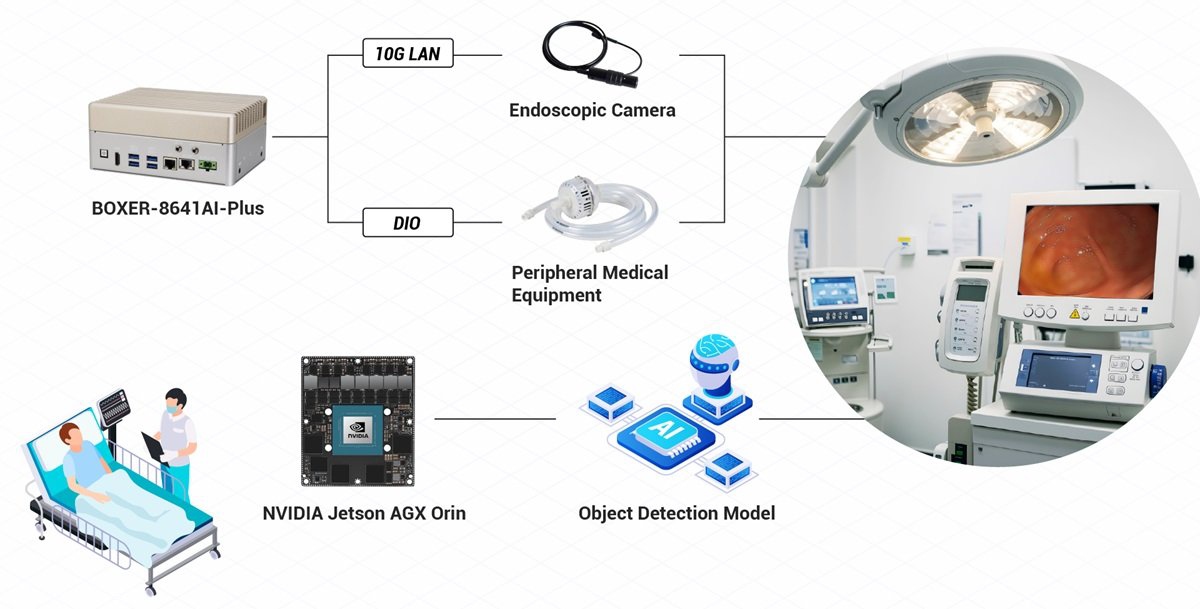Colonoscopies serve essential roles within the healthcare sphere. The first of these is in helping healthcare professionals identify a range of potentially life-threatening medical conditions, while the second is to provide key insights into risk factors that allow preventative steps to be taken in patients with heightened risk of bowel disease. However, the procedure is one that requires a high level of expertise and nuance in order to accurately interpret the findings of.
To assist healthcare professionals to identify more subtle or ambiguous signs of anomalies such as polyps, lesions, and adenomas during colonoscopies, a medical technology startup partnered with AAEON. Their objective was to develop an innovative AI-assisted colonoscopy application designed to enhance diagnostic accuracy, powered by the new BOXER-8641AI-Plus AI@Edge Fanless Embedded AI System. The broader concept behind this was that despite the already reliable methods available to healthcare professionals, the utilization of AI inferencing had the potential to not only provide clarity in interpreting more ambiguous images taken during the procedure, but could make the procedure as a whole more efficient and accurate.




The key environmental benefits to the BOXER-8641AI-Plus were threefold, its compact size, fanless design, and FCC Class B certification. Measuring just 180mm x 136mm x 79.1mm, the system was compact and easily integrated into existing equipment setups, thereby eliminating barriers to deployment.
The benefits of its fanless design were less practical and more of a necessity, given the sterile medical settings in which it would need to operate. Embedded computers that rely on active fan cooling typically do not encounter issues due to their heat dissipation mechanisms; however, the accumulation of dust and other contaminants is difficult to prevent without additional maintenance.
The BOXER-8641AI-Plus’ FCC Class B classification was a crucial factor in AAEON winning the project by demonstrating its compliance with electromagnetic compatibility (EMC) standards, which ensured the system could operate effectively without either causing electromagnetic interference (EMI) or being affected by other equipment itself. For the former, compliance indicated that the BOXER-8641AI-Plus could operate alongside multiple other devices, such as patient monitors, defibrillators, and imaging systems, without interfering with their operation through its electromagnetic emissions.
Where electromagnetic susceptibility (EMS) was concerned, the BOXER-8641AI-Plus’ compliance indicated that it would be able to resist electromagnetic interference from other equipment. As a consequence, the customer could be assured that the accuracy of the analysis provided by the device remained accurate, even when deployed alongside other devices that may emit external electromagnetic signals.
The FCC Class B classification also served to instill greater trust in the system's suitability for sensitive, patient-facing environments, making it more appealing to the customer as it would be easier to gain approval for use from regulatory bodies and a broader range of healthcare providers.

The advanced interfaces offered by the BOXER-8641 Plus made it an attractive choice for the customer, considering their project goals. Equipped with an RJ-45 port for 10G LAN, the system could support an endoscopic camera capable of delivering a continuous stream of uncompressed image data at extremely high speeds. Both features were critical for achieving real-time, high-resolution video for AI inferencing.
While collecting image data through its connected endoscopic camera, the BOXER-8641AI-Plus Plus successfully executed the customer’s proprietary AI model with the help of its integrated NVIDIA® Jetson AGX Orin™ module. With up to 275 TOPs of AI performance and 64GB of LPDDR5 memory, the use of NVIDIA® Jetson AGX Orin™ module facilitated the extremely fast and precise execution of complex object detection and image classification algorithms. Such exceptional computational power subsequently allowed the BOXER-8641AI-Plus to process high-resolution colonoscopy video data in real time to identify polyps and other abnormalities with accuracy.
The BOXER-8641AI-Plus’ pre-installed software development kit tools, which included CUDA, TensorRT, and NVIDIA DeepStream, created a stable, efficient, and developer-friendly environment that accelerated deployment and enhanced the system's performance in clinical settings.

The system's versatile selection of interfaces made it a well-rounded platform for the application, especially with respect to its two DB-9 ports supporting RS-232/485 signals, which enabled the PC to work both independently and in conjunction with peripheral devices such as barcode scanners. The BOXER-8641AI-Plus’ third DB-9 port provided a DIO interface with which the colonoscopy application could interact with peripheral equipment during procedures, such as suction devices, insufflators, or biopsy tools.

Remote management and updates were also critical to the system's success. Among the BOXER-8641 Plus’ I/O is an out-of-band (OOB) connector, which opened the door to the customer being able to undertake hardware monitoring and system status checks without needing access to the operating system or the physical machine.
Similar to the advantages offered by the BOXER-8641 Plus’ OOB capabilities, the system's over-the-air (OTA) update functionality made it possible to remotely update the application’s software, including the AI models it ran. As a consequence, additional datasets could be integrated into the customer’s existing AI model to enhance its accuracy, all without the need for in-person intervention.
The BOXER-8641AI-Plus was a central component of the application for a number of reasons. While it met the very elementary needs of an embedded computer deployed in the healthcare sector, as evidenced by its FCC Class B classification, this was merely the tip of the iceberg. The system’s precise combination of high-speed interfaces and exceptionally powerful AI performance provided a tailor-made foundation for a solution that not only enhanced the accuracy of colonoscopies but could also be applied to other areas of diagnostic imaging.
This case illustrates the remarkable potential that AI adoption has in assistive healthcare technology, wherein edge computing is able to serve a significant role in helping healthcare professionals identify abnormalities during routine screening procedures.
